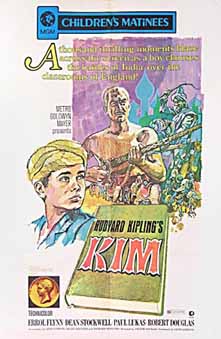
KIM
US, 1950, 113 minutes, Colour.
Errol Flynn, Dean Stockwell, Paul Lukas, Robert Douglas, Thomas Gomez, Cecil Kellaway, Arnold Moss, Reginald Owen, Laurette Luez.
Directed by Victor Saville.
Kim is the classic story by Rudyard Kipling. It focuses on a young boy and his being guided by the Red Beard, Mahbub Ali at the time of the clashes between the Indian tribes and the occupying British forces. Errol Flynn is the Red Beard, relishing this action adventure and Dean Stockwell, very popular at this time as a young star (The Green Years, The Boy with Green Hair) is Kim. An added bonus is Oscar-winning Paul Lukas (Watch on the Rhine) as the dignified Lama.
The film recreates India of Kipling’s imagination, the 19th century with its battles, spies, uprisings.
The film was remade in 1985 with Peter O’ Toole as the Lama and Bryan Brown as the Red Beard. However, this remains the classic telling of the tale.
1. How enjoyable a film was this? A good adventure? For what audience was it primarily intended? How much for children?
2. The importance of India in the 19th century? The colour and locations,# the atmosphere of India?
3. The narrative explaining for the audience what was happening and its significance? appropriateness of this for an adventure? Audience response to the atmosphere?
4. How attractive a boy was Kim? For young audiences? Could they identify with him? Kim as a 19th century hero?
5. The importance of the background of Anglo- Indian relationship? The British heritage, Empire, and its influence, the Indian heritage? The clash and the cooperation?
6. Kim as an Indian? His being portrayed as a messenger, his friendship with Redbeard, his devotion to the holy man, his begging and his education, his quickness? impressed by the incident with the snake, his overhearing the information? His going to school, St. Saviours, and the oppressive nature of school 1ife? The training for spying,, his strong will in hypnotism, his undergoing dangers and his worship of Redbeard, his growing up? The fulfilment of his dreams? how was this illustrated in particular incidents?
7. How enjoyable an actor is Errol Flynn? style? The opening threats to his life? his pose as a horse trader, his spying, weaving the plots of his death, his heroism in saving Kim at the end? A typical film hero?
8. How did the holy man contrast with this? The authentic Indian? the Buddhist spirituality? The nature of his prayer and asceticism? His care for Kim and sharing the journey with him? Death and the fulfilment of his quest? Giving more depth and significance to the film?
9, The importance of the war situation, a 19th century empire war, the oppression of the Indians and their rebellion, the British ascendency, the army, school, church? The Russians and their helping the Indians? the battles?
10. Was the climax satisfactory enough for this adventure?
11. How satisfying are adventure films like this? The appeal in past decades? Do they appeal now?